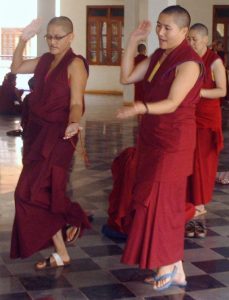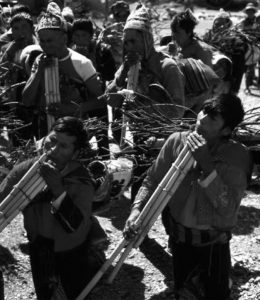Our project seeks to sketch a portrait of cyclic music in cultures worldwide, considering how the range of its varieties could be represented. Cooordinating the perspectives of music theory and ethnomusicology, principal investigators John Roeder and Michael Tenzer, along with their research associates, create and evaluate tools and methodologies for describing, analyzing, and comparing musical cycles from across the globe.
An Introduction to Our Research
In a South Asian temple three nuns chant a prayer to attain the virtuous perfections of Buddha; they maintain a constant poetic meter, but small pitch deviations shape and link their phrases. In the Bolivian highlands, two groups of panpipers alternate to play a looping eight-note dance tune that shifts some of its notes each time it repeats. Across the world in Gabon, a Bibayak singer yodels for her own amusement; alternating high and low, her melody permutes strings of notes as if constrained by the rules of some intuitive game.
- Nuns of Jangchub Choeling
- Bolivian Julajula panpipers performing a kulwa.
- Pygmy yodelling
These utterances, although they differ in function and location, are all examples from traditional societies of musical cyclicity—the persistent repetition of tonal or rhythmic patterns. Cycles generate both stability and future-directed drive, inviting and rewarding participation, even to listeners distant in time, space, and culture. Their ubiquity suggests that humans across the world, for all their wonderful diversity, share some ways of hearing and organizing sounds in time, and that they can appreciate each other’s music in terms that refer to those common abilities. Yet studies to date have focused on the most familiar examples—popular music, Euro-American miminalism, and music of Africa and its diaspora— without recognition of a wider synthesis within grasp.
Music theory facilitates communication among composers, listeners, and performers, and supports scholarly analysis and critical discourse. In this project we propose to develop an account of cycles that is general enough to apply to a wider diversity of examples, but specific enough to describe, distinguish, and appreciate the complex interactions of musical perceptions that they entail.
Consulting both the literature and living experts, and relying on our own intercultural musical experience, we will develop an intersubjective theory inductively and collaboratively. To obtain maximum diversity we focus on cycles recorded before globalization accelerated the interaction of musical cultures. We will seek cycles that range widely in length, texture, instrumentation, and social function. We will transcribe them using inventive fixed and animated graphics, analyze them with reference to basic musical capabilities that humans share, and make our analyses available in books, articles, conference papers, videos, and this public website.
The theory will help articulate and explain the surprising multiplicity of experiences that this ostensibly simple technique affords. It will also help pinpoint what the musics share. Our study will broaden the content and scope of cycle theory and contribute to the growing field of world music analysis. Applying our results, we will design new inclusive pedagogies of music theory and offer our humanistic observations as a resource to ongoing scientific research into human musicality. [John Roeder]



